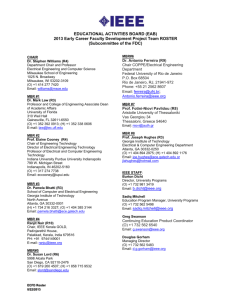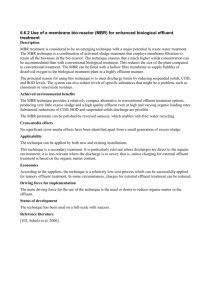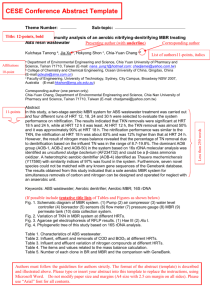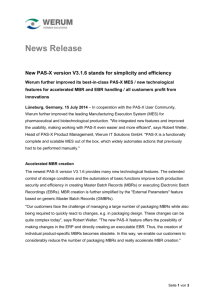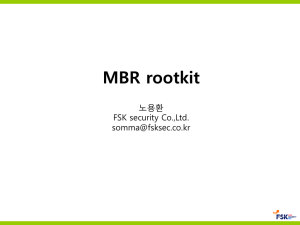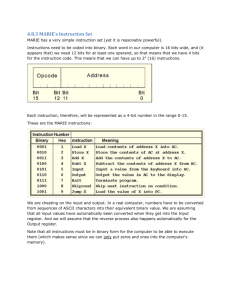Methyl Bromide and the Montreal Exemption and Quarantine Pre-Shipment Process
advertisement
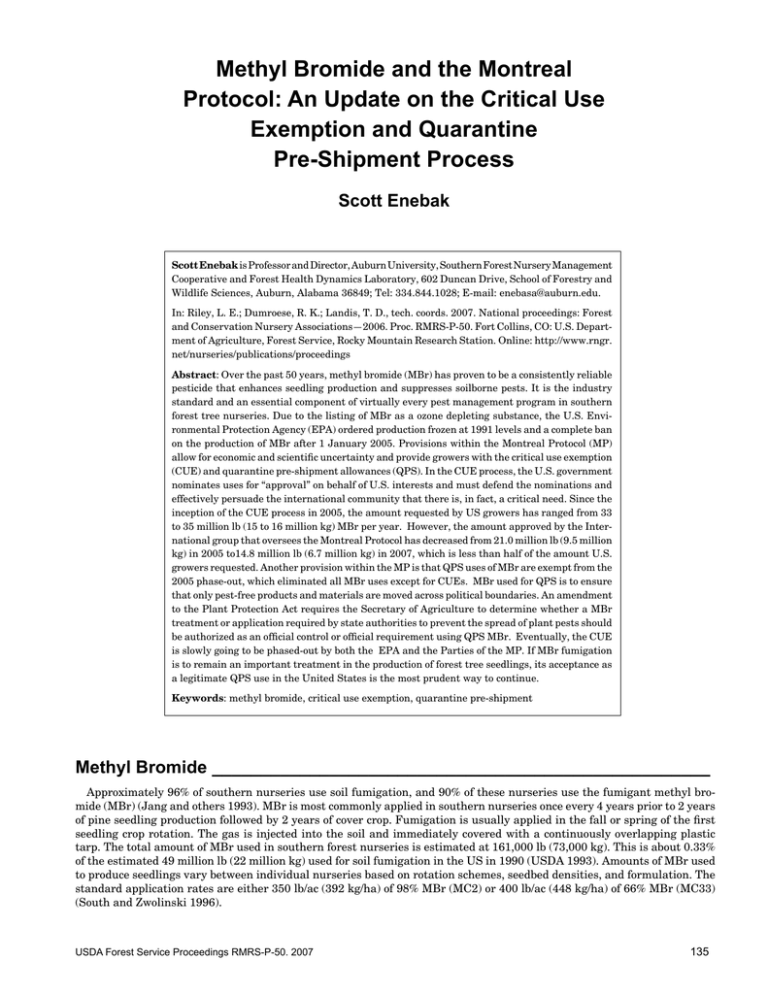
Methyl Bromide and the Montreal Protocol: An Update on the Critical Use Exemption and Quarantine Pre-Shipment Process Scott Enebak Scott Enebak is Professor and Director, Auburn University, Southern Forest Nursery Management Cooperative and Forest Health Dynamics Laboratory, 602 Duncan Drive, School of Forestry and Wildlife Sciences, Auburn, Alabama 36849; Tel: 334.844.1028; E-mail: enebasa@auburn.edu. In: Riley, L. E.; Dumroese, R. K.; Landis, T. D., tech. coords. 2007. National proceedings: Forest and Conservation Nursery Associations—2006. Proc. RMRS-P-50. Fort Collins, CO: U.S. Department of Agriculture, Forest Service, Rocky Mountain Research Station. Online: http://www.rngr. net/nurseries/publications/proceedings Abstract: Over the past 50 years, methyl bromide (MBr) has proven to be a consistently reliable pesticide that enhances seedling production and suppresses soilborne pests. It is the industry standard and an essential component of virtually every pest management program in southern forest tree nurseries. Due to the listing of MBr as a ozone depleting substance, the U.S. Environmental Protection Agency (EPA) ordered production frozen at 1991 levels and a complete ban on the production of MBr after 1 January 2005. Provisions within the Montreal Protocol (MP) allow for economic and scientific uncertainty and provide growers with the critical use exemption (CUE) and quarantine pre-shipment allowances (QPS). In the CUE process, the U.S. government nominates uses for “approval” on behalf of U.S. interests and must defend the nominations and effectively persuade the international community that there is, in fact, a critical need. Since the inception of the CUE process in 2005, the amount requested by US growers has ranged from 33 to 35 million lb (15 to 16 million kg) MBr per year. However, the amount approved by the International group that oversees the Montreal Protocol has decreased from 21.0 million lb (9.5 million kg) in 2005 to14.8 million lb (6.7 million kg) in 2007, which is less than half of the amount U.S. growers requested. Another provision within the MP is that QPS uses of MBr are exempt from the 2005 phase-out, which eliminated all MBr uses except for CUEs. MBr used for QPS is to ensure that only pest-free products and materials are moved across political boundaries. An amendment to the Plant Protection Act requires the Secretary of Agriculture to determine whether a MBr treatment or application required by state authorities to prevent the spread of plant pests should be authorized as an official control or official requirement using QPS MBr. Eventually, the CUE is slowly going to be phased-out by both the EPA and the Parties of the MP. If MBr fumigation is to remain an important treatment in the production of forest tree seedlings, its acceptance as a legitimate QPS use in the United States is the most prudent way to continue. Keywords: methyl bromide, critical use exemption, quarantine pre-shipment Methyl Bromide____________________________________________________ Approximately 96% of southern nurseries use soil fumigation, and 90% of these nurseries use the fumigant methyl bromide (MBr) (Jang and others 1993). MBr is most commonly applied in southern nurseries once every 4 years prior to 2 years of pine seedling production followed by 2 years of cover crop. Fumigation is usually applied in the fall or spring of the first seedling crop rotation. The gas is injected into the soil and immediately covered with a continuously overlapping plastic tarp. The total amount of MBr used in southern forest nurseries is estimated at 161,000 lb (73,000 kg). This is about 0.33% of the estimated 49 million lb (22 million kg) used for soil fumigation in the US in 1990 (USDA 1993). Amounts of MBr used to produce seedlings vary between individual nurseries based on rotation schemes, seedbed densities, and formulation. The standard application rates are either 350 lb/ac (392 kg/ha) of 98% MBr (MC2) or 400 lb/ac (448 kg/ha) of 66% MBr (MC33) (South and Zwolinski 1996). USDA Forest Service Proceedings RMRS-P-50. 2007 135 Enebak Methyl Bromide and the Montreal Protocol: An Update on the Critical Use Exemption . . . MBr is used to control weed seeds, soilborne fungi, nematodes, and insects. Formulations with 2% chloropicrin are suggested when perennial weeds and nematodes are the primary pest problem, while formulations containing 33% chloropicrin are used when more difficult-to-kill fungi are the target pests (South and Zwolinski 1996). MBr fumigants were instrumental in greatly reducing the impact of difficultto-control soil fungi, such as the charcoal root rot pathogen (Macrophomina phaseolina) (Seymour and Cordell 1979), and has been superior to soil drenches containing fungicides for the control of Fusarium spp. (Rowan 1981). Formulations of MBr help control perennial weeds, such as nutsedge (Cyperus spp.), which currently registered pre-emergent herbicides seldom adequately control. Postemergent nutsedge control is limited because of the lack of herbicide selectivity to this weed. The use of MBr for weed control in hardwood seedbeds is even more critical because of the lack of suitable pre- or post-­emergent herbicides when growing hardwood seedlings (South 1994). In those situations, nursery managers often fumigate immediately prior to every hardwood seedling crop to reduce the amount of hand weeding that would be required otherwise. The extensive use of MBr in forest tree nurseries across the South (Jang and others 1993) is the best indication of its consistent effectiveness across a wide range of conditions. Moreover, increases in both seedling size and seedling numbers after fumigation are well documented in studies carried out in forest tree nurseries over the last 40 years. After the superiority of MBr was established 50 years ago, little additional research occurred until the loss of MBr use became likely under the Montreal Protocol. For these comparisons, non-fumigated beds produced 33% fewer seedlings than those fumigated with MBr or MC33. Non-fumigated beds contained 27% fewer seedlings than metham-sodium (SMDC) treatments, which were the second best in average performance of the widely tested fumigants. Based on average performances, where MBr fumigated beds produced 100 seedlings, controls would be expected to produce 67 seedlings. Using a southwide production figure of 1.0 billion seedlings (McNabb and Santos 2004), MBr could theoretically be responsible for 33% of this production, or 333 million seedlings. Calculating at US$ 40/1000 seedlings, the value of this seedling production increase is U.S.$ 13.3 million annually. Not only has MBr increased the average number of seedlings produced per unit area of nursery bed, it has also increased the average size of those seedlings. A review of 36 published comparisons conducted over the past 40 years in which some aspect of seedling size was compared between seedlings from non-fumigated and MBr treated beds found that seedlings from the MBr treated beds were, on average, 14% larger (Carey 1994). The effect of bed density on seedling size was not addressed in the original reports, but logical inferences can be made. If fumigation affected the number of seedlings without enhancing the growth of individual seedlings, then as bed density increased, mean seedling size would decrease, not increase. MBr simply produces more seedlings and bigger seedlings when used over other soil fumigants. There is a general conception that MBr is universally toxic to all organisms and that fumigated soils are left essentially sterile. This is not true, and populations of soil fungi after 136 fumigation are well documented (Munnecke and others 1978). For example, Trichoderma has been shown to be resistant to MBr. This highly competitive soil fungus suppresses several pathogenic fungi (Strashnow and others 1985). In Auburn University Southern Forest Nursery Management Cooperative (AU SFNMC) trials throughout the South, Trichoderma has consistently increased after treatments with MBr or chloropicrin, but decreased after some other treatments (Carey 1995, 1996). Foster (1961) concluded 35 years ago that “MBr may well be as important for what it leaves in the soil as for what it removes.” It is unfortunate, and surprising, that differences in the “selectivity” of MBr among microbes is known with little more precision today than in 1961. Over the past 50 years, MBr has proven to be a consistently reliable pesticide that enhances seedling production and suppresses soilborne pests. It is the industry standard and is an essential component of virtually every pest management program in southern forest tree nurseries. By reducing populations of many pests, the use of MBr can reduce the demand for more specific pesticides such as herbicides, fungicides, and insecticides. Moreover, MBr typically results in superior seedling growth. There is little doubt that MBr is one of the most important pesticides used in the production of forest tree seedlings in the southern United States. Nursery managers and pest specialists should be concerned about the restrictions and probable loss of this important pesticide. Montreal Protocol_ ______________ During the last 25 years, a consensus emerged in the scientific literature that the concentration of stratospheric ozone was declining, and that chlorinated fluorocarbons (CFCs) were the cause. To address this, the Montreal Protocol was signed by several nations in 1987 to bring about the eventual phase-out of CFCs and substances that deplete the ozone layer. Little attention was given to bromine until 1991, when its class of chemicals was added to a growing list of potential ozone depletors. The contributions of what are currently thought to be the significant ozone depletors are presented in table 1, with the amount of MBr used in agriculture a small part of the picture. Unlike the CFCs, which are all man-made, there are significant natural sources and sinks of MBr (Butler 1994). Approximations based on what are thought to be major sources include: oceans at 35 million kg (77 million Table 1—Stratospheric ozone depletors. Source Chlorinated fluorocarbons (CFCs) Halogens Natural MBr—oceans Natural MBr—fires Manufactured MBr—world agriculture Manufactured MBr—exhausts Manufactured MBr—U.S. agriculture Abundance percentage 82 8 4 3 2 1 <1 USDA Forest Service Proceedings RMRS-P-50. 2007 Methyl Bromide and the Montreal Protocol: An Update on the Critical Use Exemption . . . lb), fires at 30 million kg (66 million lb), motor vehicles at 15 million kg (33 million lb), and MBr manufactured for pesticides at 30 million kg (66 million lb). However, there are significant problems with calculating these numbers. These and most other estimates include a margin of error of about 50%. Secondly, the estimated magnitudes of MBr sources have changed considerably over the years. For example, the magnitude of fire (used largely to clear land for agriculture) as a source was only recently discovered (Mano and Andreae 1994), as was the potential for the oceans to function as both a source and a sink for MBr, possibly compensating for changes in other sources (Butler 1994). Some of these other sources have been determined to be soilborne fungi. Lee-Taylor and Holland (2000) reported that whiterot fungi were significant global producers/emitters/sources of stratospheric MBr. Redeker and others (2004) reported ectomycorrhizae to be important sources of methyl bromide in the atmosphere. Also, under many soil conditions, 50% or less of MBr applied during fumigation “escapes” into the atmosphere (Gan and others 1995). In 1993, the atmospheric residence time of MBr was estimated to be close to 2 years (Mano and Andreae 1994), but recently has been estimated to be as short as 9 months (Adler 1995). The U.S. Environmental Protection Agency (EPA) ordered production of MBr frozen at 1991 levels and a complete ban on the production after 1 January 2005. Legal jurisdiction for this ban falls under the Clean Air Act, which the EPA administers. Even though Montreal Protocol signees decided in 1992 that the MBr issue should be reconsidered in 1995 after a thorough technical options assessment, MBr was already (in 1992) scheduled for termination in the US. This was due to lawsuits brought by several environmental groups which triggered an automatic phase-out of MBr under the Clean Air Act, which addresses chemicals suspected of depleting stratospheric ozone. The Montreal Protocol, not the Clean Air Act, has allowances for the economic and scientific uncertainty of the source and sinks of MBr in the stratosphere, that is, the critical use exemption and quarantine pre-shipment allowances. In the international schedule to phase out MBr, governments under the MP agreed that developed countries would cut MBr consumption by 25% in 1999, 50% in 2001, 70% in 2003, and a complete phase-out in 2005. The quarantine pre-shipment and critical emergency uses are exempt from these controls after 2005 in the United States and other developed countries. Developing countries needed to reduce their consumption by 20% in 2005 and to phase out MBr use by 2015, except for QPS and critical emergency uses. The year 2005 arrived without an effective and economic alternative to MBr available to US growers. EPA and CUE Process____________ The MBr critical use exemption (CUE) program under the Montreal Protocol provides a mechanism for growers to legally use a pesticide that cannot otherwise be used and allows the EPA a means to grant exceptions to a general rule. The program assumes there are cases where it is appropriate to grant such exceptions. The CUE process requires applications or petitions to be filed with the EPA presenting the case for being granted an exception. The CUE requires USDA Forest Service Proceedings RMRS-P-50. 2007 Enebak technical and economic data on alternatives available to the user so EPA can assess whether the desired use of the pesticide is really important. However, CUEs must pass through an international panel of governmental representatives from countries throughout the world (Parties to the Montreal Protocol) based on applications filed with the EPA by growers and/or consortia of growers. In the CUE process, the U.S. Government nominates uses for “approval” on behalf of U.S. interests and must defend the nominations and effectively persuade the international committee (the Technology and Economic Assessment Panel [TEAP] and the Methyl Bromide Technical Option Committee [MeBTOC], which make recommendations to the Parties) that there is, in fact, a critical need. The U.S. Government decides what to nominate based on the review of application materials by the EPA, the USDA, and the U.S. Department of State. The applicants must demonstrate that there are no technically and economically feasible alternatives, that associated use and emissions from MBr are minimized, and that there have been past, and will be future, efforts to find alternatives. In short, in order to defend the U.S. nomination at an international level, the EPA requests a significant amount of information to help U.S. representatives present a solid justification for the U.S. nomination decisions. Because of the shear number of MBr users in the United States, the EPA strongly encouraged MBr users to file a CUE as a group or consortia that included a “representative user.” Instead of providing detailed information about each operation represented in an application, applicants were to group themselves based on similar growing conditions or regions. By providing basic size, climate, and soil information about the average or typical operation, the US delegation had a better understanding of the specific constraints a particular group or applicant was facing. Within the forest nursery seedling group, there were 8 CUE pre-plant applicants that were grouped by region within the United States. A few of these consortia or regions included International Paper, Weyerhaeuser Southeast, Weyerhaeuser Northwest, Michigan Seedling Association, and the Southern Forest Nursery Management Cooperative. As the major user of MBr worldwide, the US requests were heavily scrutinized by the Parties of the Montreal Protocol. In some instances, the EPA took the position that research results and data from applicants may not be available. For example, many research studies conducted by the AU SFNMC have tested the efficacy of alternatives without collecting seedling production and quality data on the costs compared to MBr alternatives. While the CUE application did not mention this specifically, narrative information was acceptable as long as the information provided helped the applicant make the best case possible for the use of methyl bromide post-phase-out. To that end, the AU SFNMC added 24 pages of appendix material to their CUE application to provide additional information that was not required in the application. The information from each CUE application is then compiled in the Methyl Bromide Usage Numerical Index (BUNI) and the Methyl Bromide Usage New Numerical Index (BUNNI) which is used to make the case for MBr use in those critical areas to the Parties of the Montreal Protocol. In addition to EPA personnel, scientists within the USDA also participated in the review of each CUE application. For 137 Enebak Methyl Bromide and the Montreal Protocol: An Update on the Critical Use Exemption . . . the most part, the USDA review focused on the economic impact and technical feasibility of alternatives suggested by MeBTOC, as well as the list of non-chemical alternatives which would not be suitable in the US. In evaluating the CUE applicants, both the USDA and EPA jointly present their recommendations to an interagency panel, led by the U.S. Department of State, who ultimately submitted the U.S. CUE nominations to the Parties of the Montreal Protocol. Despite numerous attempts by the U.S. Department of State to make the application and awarding of CUEs cover more than 1 year, the Parties have kept the year-by-year application process. There is no reason to believe this will change. The schedule is tight for the application, compilation, and awarding of CUEs. This schedule typically results in notification of exemption immediately prior to the previous year’s phase-out date. That tight deadline of “nominating and awarding” should change this year (2006) as the deadline for U.S. growers CUE submission to the EPA was moved up 1 month, to 10 July 2006, to facilitate the Parties meeting earlier in 2006. The amount of MBr that was made available to growers in the US after going through the entire process of CUE application, EPA, USDA, U.S. Department of State, and the Parties of the MP over the past 3 years is shown in table 2. While the amount requested by MBr users in the United States to the EPA has remained in the 33 to 35 million lb/ year (15 to 16 million kg/year), the amount subsequently nominated by the EPA/USDA to the Parties has decreased from 23.7 million lb (10.8 million kg) in 2005 to 16.3 million lb (7.4 million kg) in 2007, or less than half of what U.S. growers requested. Some of the reduction by the EPA in the amount nominated is due to “double-counting” and quarantine pre-shipment uses. However, the situation is even more dire at the International level, as the Parties have approved 2 to 5 million lb (0.9 to 2.3 million kg) less than U.S. EPA requested. All MBr figures are based on a percentage (30%) of US baseline production levels (56.2 million lb [25.5 million kg]) in 1991. What confounds the MBr usage even further is that the amount awarded each year by the Parties is comprised of both “new MBr production” and “existing MBr stock piles,” that is, MBr produced and stored prior to the 2005 phase-out. In 2005, the 37% of MBr allowed for critical users could come from 30% new production and 7% from existing stock piles. A 5% usage from stock piles was required in 2006, with 21.8% allowed from new MBr production. However, in 2007, there was a cap of 20% new MBr production, and the remaining 6.4% must come from existing stock piles. The total difference between what could be produced in 2005 and what can be produced in 2007 is about 5 million lb (2.3 million kg) of MBr. Using Table 2—Methyl bromide requests, nominations, and approvals through the critical use exemption process, 2005 to 2007. 2005 2006 2007 CUE applications to EPA EPA nomination to the parties Montreal Protocol approved 34.1 23.7 21.0 33.8 20.7 15.2 35.1 16.3 14.8 Percentage baseline, 1991 usage 37 26.8 24.6 a a MBr in millions of pounds (1 lb = 0.45 kg). 138 a rate of 300 lb/ac (336 kg/ha), that difference equates to a reduction in MBr availability for fumigation of over 16,000 ac (64,75 ha). The economic reality of the supply/demand curve and subsequent cost per pound is sure to continue to play a role. While the demand remains constant (33 to 35 million lb [15 to 16 million kg]), the supply of MBr is being decreased. Since the implementation of the CUE process, the cost to fumigate 1 ac (0.4 ha) of nursery soil has increased from U.S.$ 1,500/ac (U.S.$ 3,750/ha) in 2000 to over U.S.$ 2,100/ac (U.S.$ 5,250/ha) in 2006 (table 3). With respect to the CUE allocation process, the AU SFNMC was against the lump-sum, or Universal Allocation, of MBr stocks, as we believed that one large pot of MBr would be detrimental to the sectors that were to have access to CUE MBr. There was concern that the market forces would not allow forest tree nurseries to afford MBr, and the lump sum allocation would go to the “highest” bidder. While the EPA indicated in their final CUE ruling in 2004 that the lumpsum method would most likely “mimic market allocation,” and this method would be “less burdensome” with respect to paperwork, there has been a 42% increase in MBr price/cost to forest seedling growers since 2000. Thus, it appears our concerns in 2004 were correct and that market forces have acted negatively towards forest nursery seedling producers in their ability to obtain MBr under the CUE process. The provisions within the Montreal Protocol (CUE, QPS, Emergency Use) were set up as safe-guards to protect the Parties while ensuring the reduction of ozone depleting chemicals over time. There is no provision or time-line in the Protocol that indicates the CUE application process will end in a specific year. However, the Montreal Protocol was designed to stop the production and use of ozone depleting compounds. That is the ultimate goal of the treaty and of MeBTOC. The reality is that, eventually, the CUE application process will cease to exist. While there still may be critical users who need MBr, there will be no provision for them to obtain MBr in the United States. QPS Process, EPA, APHIS and State Plant Protection Officers_ ________ Another provision within the Montreal Protocol is that MBr for Quarantine Pre-Shipment (QPS) is exempted from the 2005 phase-out except where CUEs have been obtained. Article 2H of the Montreal Protocol, paragraph 6 states that: “… the calculated levels of consumption and production under this Article shall not include the amounts used by the Party for quarantine and pre-shipment applications.” Initially, most of the MBr used worldwide was not considered a QPS commodity and there was not a great emphasis to regulate it. However, over the past 10 years, QPS consumption has increased to about 22% of global fumigant use. Most of the increased use is due to the increasing import and export trade, as MBr is the main quarantine treatment for rapid treatment of imported fresh fruits, vegetables, flowers, timber, and grains found on arrival to be infested with unwanted pests. The use of MBr for quarantine pre-shipment can also be used to ensure that pest-free seedlings can be moved across political boundaries. The MeBTOC has shown some interest in US QPS MBr use by requesting the amount of MBr used for such purposes in the CUE application. At USDA Forest Service Proceedings RMRS-P-50. 2007 Methyl Bromide and the Montreal Protocol: An Update on the Critical Use Exemption . . . Enebak Table 3—Relative cost to fumigate an acre of nursery soil using the various sources of MBr, 1997 to 2006 (in U.S. $). Source of MBra Regular MBrb QPS MBr CUE MBrd Year 1997 1998 1999 2000 2001 2002 2003 2004 2005 2006 $1171 – – $1175 – – $1448 – – $1516 – – $1606 – – $1650 $1466 – $1729 $1500 – $1780 $1547 – NAc $1632 $2017 NA $1650 $2150 Source or “pot” of MBr available to US producers/distributors/users. MBr on the market prior to the formation of QPS and CUE MBr sources. This source of MBr became unavailable after the total phase-out of MBr on 1 January 2005. In 2001, there was a 50% reduction of MBr production (baseline 1991 levels; 56.2 million lb [25.5 million kg]) mandated by the Montreal Protocol. c Phased out of use. d Became available to Critical Users in 2005 as outlined by the Montreal Protocol and agreed to by the Parties. a b the most recent Open Ended Working Group Meeting of the Montreal Protocol in July 2006, the TEAP reported on 2003 to 2004 QPS usage. While there were no proposals to cap or regulate QPS, the intent of the report was clear; first we track QPS usage, then we regulate it. The QPS regulations were clearly an issue which was left to the individual signees of the Montreal Protocol as stated in Article 2H. The fact that TEAP and the European Community are asking questions about U.S. QPS regulations is not a good omen for growers who currently use MBr under QPS guidelines. In 2003, the EPA ruled in a letter to AU SFNMC that forest tree seedlings that are shipped across state boundaries (interstate) qualify under the quarantine and pre-shipment guidelines for MBr use. Thus, nurseries that plan to ship seedlings across state lines can fumigate the areas within the nursery that are going to grow those seedlings with QPS MBr. Those nurseries do not need to be a critical user, nor require a CUE under the CUE process. However, there are strict rules and steps that need to be taken to use QPS MBr, and fines to the applicator and user if QPS is misused. In these instances, and for some nurseries, interstate QPS MBr may address a part of their seedling production. However, for many smaller private and state nurseries, the use of interstate QPS MBr may not benefit them at all. After the 2003 ruling on interstate QPS, the AU SFNMC forwarded sections of agricultural regulations that required nursery inspections for plant health before shipment from the 11 southern states to the EPA to get their support of QPS for intrastate fumigation. The EPA responded in 2004 to the SFNMC that “those regulations did not meet the necessary requirements for QPS allocation.” In their response, they indicated that “while those southern states did not meet the necessary requirements, a few state regulations, in particular Oregon and California, have rules that would allow the use of intrastate QPS.” In addition, what would be required on the state’s requirements was language that “specifically prohibits movement between local jurisdictions unless the commodities are free of pests.” Shortly after the EPA ruling on intrastate use of QPS MBr in forest tree nurseries, a new factor in determining QPS eligibility appeared. This new factor came as an amendment to the Plant Protection Act. The regulation of non-native and exotic invasive pests, or pests from one area of the United States to another, has been one purview of the Animal Plant Health Inspection Service (APHIS). Their involvement with the MBr, CUE, and QPS process came to a head with the passage of Section 19 of the Plant Protection Act. This act put into place steps that put APHIS, USDA, and EPA in line USDA Forest Service Proceedings RMRS-P-50. 2007 with respect to regulating the use of MBr in the management of quarantine pests. The amendment requires the Secretary of Agriculture, “upon request of State, local, or tribal authorities, to determine whether a MBr treatment or application required by those authorities to prevent the introduction, establishment or spread of plant pests or noxious weeds should be authorized as an official control or official requirement.” The administrator of APHIS, acting for the Secretary, will determine if MBr will be considered as an official quarantine treatment within 90 days of a request by State, local, or tribal authority. Language in section 419 of the Plant Protection Act applies directly to forest tree nurseries: States regulate movement of commodities to prevent the introduction of undesirable pests from another State or from a locality within the State into another locality within that State. Examples of localities may include a county, a township, a region occupied by a nursery which provides the source plant material for production crops …The regulation may specifically require fumigation or the regulation may be performance-based, requiring phytosanitary certification that a certain commodity is free, or ‘apparently free’ of regulated pests prior to geographic movement … An example of a potential situation in which legislation may be beneficial for agricultural commodities is the need for methyl bromide to fumigate soil for propagative material such as forest tree seedlings, prior to transport and planting … Alternatively, it is possible under such legislation that methyl bromide use would be allowed for establishing material as pest-free even under a broad performance standard [bold emphasis added by author]. Following the intrastate ruling by the EPA and passage of the Plant Protection Act, the AU SFNMC began the process of working with the departments of agriculture in many of the southern states to get qualifying legislation to APHIS for at least an opinion of its suitability for having MBr listed as a QPS treatment based on phytosanitary certification. These included the states of Virginia, North Carolina, South Carolina, Tennessee, Georgia, Alabama, Mississippi, Louisiana, Texas, Arkansas, and Oklahoma. Each plant protection officer was contacted and brought up to speed with respect to the alphabet soup of acronyms (PPA, CUE, EPA, APHIS, MP, MBr) and what was needed to get language in their state regulations that would permit the use of intrastate QPS MBr. After 2 years of working with the various state plant protection officers, the results to date of our efforts to obtain some relief with respect to intrastate QPS rules is shown in table 4. Currently (July 2006), only Alabama and Mississippi have 139 Enebak Methyl Bromide and the Montreal Protocol: An Update on the Critical Use Exemption . . . Table 4—Contacts with Plant Protection Officers and progress made with respect to proposing language for phytosanitary rules to allow intrastate QPS MBr, July 2006. Number of times contacted State Alabama 11 Arkansas Georgia 9 24 Last State response 3 May 2006 “I have assigned my Inspection and Quarantine section head the task of evaluating our regulations to see where we might be able to accommodate the addition of language to handle this request. We will be considering this more fully in the coming weeks.” 28 June 2006 “I should have their response any day now. Once approved for proposal, the regulation will be published for a 30-day comment period. Should the industries favor this regulation change, the new rule would become effective after an additional 30-day period.” “We will work on changing our regulations to address this situation in the near future.” Louisiana 11 18 May 2006 Mississippi 1 Rule Finalized North Carolina 12 5 April 2006 “Working on it.” 19 May 2006 “I visited with John Burwell, Director of our Forestry Division, and he assures me that his division will soon begin working with our Office … on this … methyl bromide issue. They plan to begin work in July to draft new rules. Once we have the rules completed and approved by our Board of Agriculture, they will go to the Legislature and the Governor for their approval next session, which begins in February 2007.” Oklahoma 12 South Carolina 8 20 April 2006 “I did receive an email on this topic recently—perhaps it was forwarded to me by someone else—and I sent it through the agency for comments. The Southern Plant Board recommended last week that we support the use of methyl bromide for this purpose. So, unless I get comments back to the contrary, that is probably what SC will do. I will keep you posted on this issue.” Tennessee 12 12 May 2006 “I am working on the Cert Committee paper and will forward within our group within a week or so for editing, refining, and consensus.” 5 July 2006 “We are drafting a legislation to cover the use of methyl bromide for intrastate and interstate shipments of forest tree seedlings … I hope to have the proposed rule ready in 2 to 3 weeks for public comment. Assuming no negative comments, the process of finalizing the rule would take about 3 months since the initial publication. Then the next process of requesting USDA approval of methyl bromide use would begin.” 30 June 2006 “We are working with the National Plant Board who are collaborating with the USDA/APHIS to address the need for continuation of the use of MBr for this purpose. Obviously we are guided by the Montreal Accord and are taking no legislative action until we receive clear guidance from the National Plant Board.” Texas Virginia 14 9 modified their plant regulatory language to allow intrastate use of QPS MBr. Thus, forest tree nurseries in those states do not need a CUE to fumigate their nursery beds with MBr and can use QPS MBr for their entire seedling production, whether the seedlings are being shipped within or outside of their state. While many forest tree nurseries have filed CUEs 140 response Rule Finalized to ensure MBr availability in the short term, as outlined above, the availability of MBr through the CUE process will eventually be phased out, only a little slower. Therefore, if MBr fumigation is important to forest tree nurseries, its acceptance as a legitimate use of QPS MBr to ensure pestfree seedlings is the best way to go. USDA Forest Service Proceedings RMRS-P-50. 2007 Methyl Bromide and the Montreal Protocol: An Update on the Critical Use Exemption . . . Summary_ _____________________ Methyl bromide has a proven record as a safe and effective pesticide in forest tree nurseries during the past 50 years. By controlling soilborne pests, MBr has consistently enhanced the production of larger numbers of improved quality seedlings per unit of land. The reliability of this pest control program has allowed nursery managers to concentrate on improving seedling quality in such areas as size, morphology, and nutrient balance, and in increasing seedling uniformity and customer satisfaction. None of the chemical or cultural methods investigated as possible replacements for MBr fumigations have been as cost effective as MBr. None of the alternatives control the wide variety of soilborne pests controlled by MBr. There is clearly no “economically and viable alternative” available for the production of forest tree seedlings. The Critical Use Exemption is going to be slowly phased out by the EPA, reducing the critical uses/users/amounts nominated and resulting in the EPA’s requested amount being denied by MeBTOC. When future MBr amounts are approved, the amount from MBr stocks will increase while new MBr production is decreased. Methyl bromide used in the CUE process is going to get more expensive, becoming cost-prohibitive to forest tree growers. If MBr fumigation is important to forest tree nurseries, its acceptance as a legitimate QPS use in the US is the most prudent way to continue. References_____________________ Adler T. 1995. Methyl bromide doesn’t stick around. Science News 148:278. Butler JH. 1994. The potential role of the ocean in regulating atmospheric CH3Br. Washington (DC): American Geophysical Union. Paper 93L-4134-R. Carey WA. 1994. Historical efficacies of fumigants in forest tree nurseries. In: Newsletter. Auburn University Southern Forest Nursery Management Cooperative. 9 p. Carey WA. 1995. Testing alternatives to methyl bromide at New Kent Nursery. Auburn (AL): Auburn University Southern Forest Nursery Management Cooperative. Research Note 95-1. 4 p. USDA Forest Service Proceedings RMRS-P-50. 2007 Enebak Carey WA. 1996. Testing alternatives to methyl bromide at Winona Nursery. Auburn (AL): Auburn University Southern Forest Nursery Management Cooperative. Research Note 96-2. 4 p. Foster AL. 1961. Control of black root rot of pine seedlings by soil fumigation in the nursery. Georgia Forest Research Council. Report No 3. 7 p. Gan J, Yates SR, Wang D, Ernst FF. 1995. Reducing fumigant volatilization through optimized application and soil management. In: Annual international research conference on methyl bromide alternatives and emissions reductions; 1995 November 6-8; San Diego, CA. 26-1. Jang E, Wood WS, Dorschner K, Schaub J, Smith D, Fraedrich S, Hsu H. 1993. Methyl bromide phase out in the US: impact and alternatives. In: USDA workshop on alternatives for methyl bromide; 1993 June 29 - July 1; Crystal City, VA. Lee-Taylor JM, Holland EA. 2000. Litter decomposition as a potential natural source of methyl bromide. Journal Geophysical Research 105:8857-8864. Mano S, Andreae MO. 1994. Emission of methyl bromide from biomass burning. Science 263:1255-1257. McNabb K, Santos H. 2004. A survey of forest tree seedling production in the south for the 2003-2004 planting season. Auburn (AL): Auburn University Southern Forest Nursery Management Cooperative. Technical Report 04-02. 10 p. Munnecke DE, Bricker JL, Kolbezen MJ. 1978. Comparative toxicity of gaseous methyl bromide to ten soil-borne, phytopathogenic fungi. Phytopathology 68:1210-16. Redeker KR, Treseder KK, Allen MF. 2004. Ectomycorrhizal fungi: a new source of atmospheric methyl halides? Global Change Biology 10:1009-1016. Rowen SJ. 1981. Soil fumigants and fungicide drenches for control of root rot of loblolly pine seedling. Plant Disease 65:53-55. Seymour CP, Cordell CE. 1979. Control of charcoal root rot with methyl bromide in forest nurseries. Southern Journal of Applied Forestry 3:104-108. South DB. 1994. Weed control in southern hardwood nurseries. In: Landis TL, editor. National proceedings: forest and conservation nursery associations 1994. Fort Collins (CO): USDA Forest Service, Rocky Mountain Forest and Range Experiment Station. General Technical Report RM-GTR-257. p 31-37 . South DB, Zwolinski JB. 1996. Chemicals used in southern forest nurseries. Southern Journal of Applied Forestry 20:127-135. Strashnow Y, Elad Y, Sivan A, Chet I. 1985. Integrated control of Rhizoctonia solani by methyl bromide and Trichoderma harzianum. Plant Pathology 34:146-151. USDA. 1993. The biologic and economic assessment of methyl bromide. Washington (DC): USDA National Association of Pesticide Impact Assessment Program. 99 p. 141
